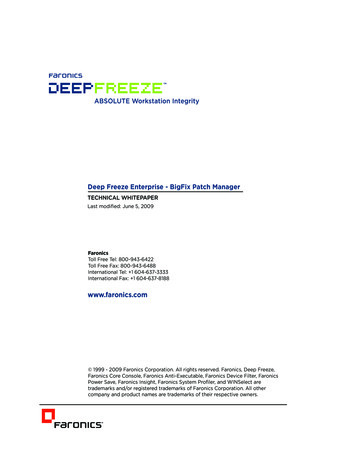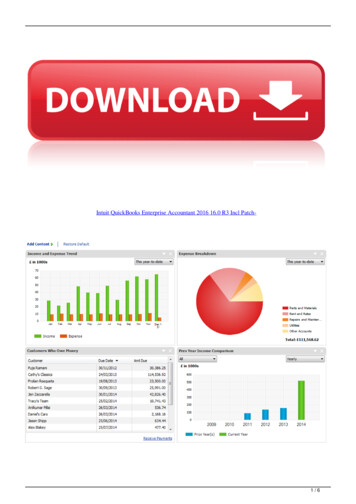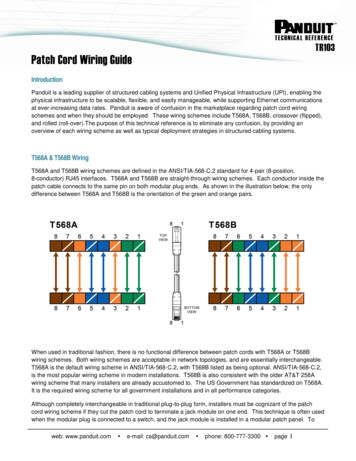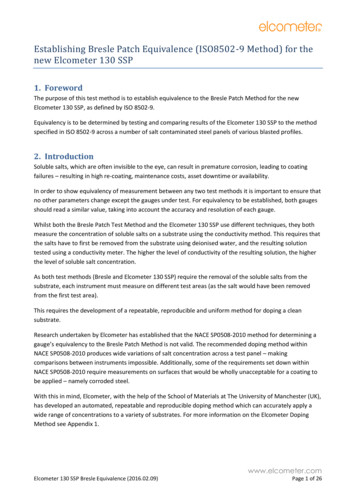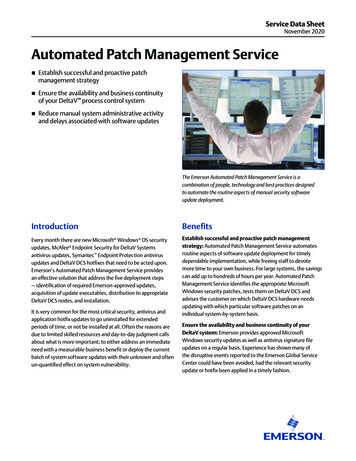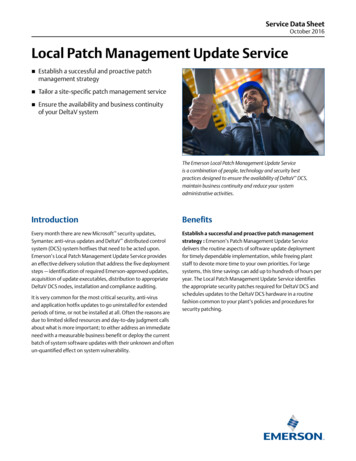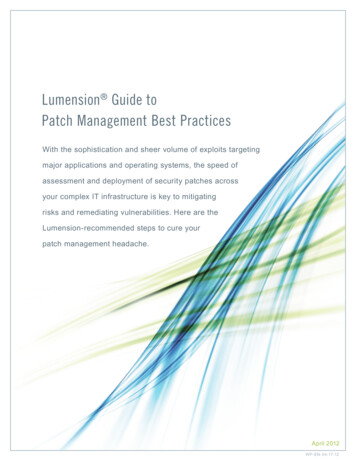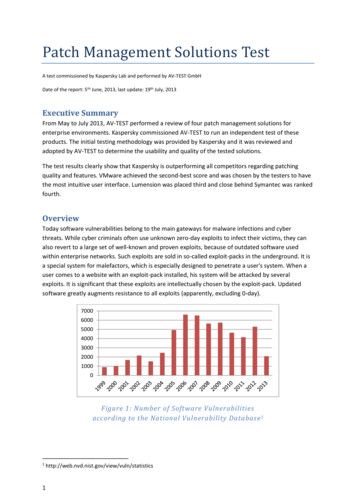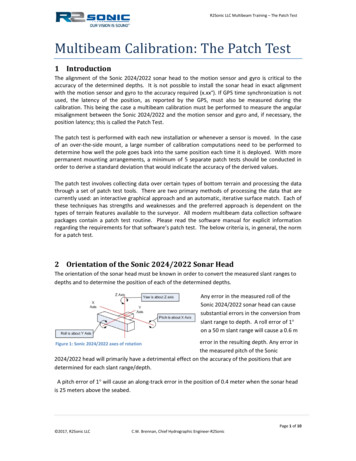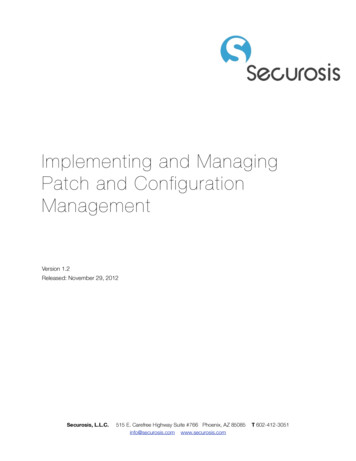
Transcription
Implementing and ManagingPatch and ConfigurationManagementVersion 1.2Released: November 29, 2012Securosis, L.L.C.515 E. Carefree Highway Suite #766 Phoenix, AZ 85085info@securosis.com www.securosis.comT 602-412-3051
Author’s NoteThe content in this report was developed independently of any sponsors. It is based on material originallyposted on the Securosis blog, but has been enhanced, reviewed, and professionally edited.Special thanks to Chris Pepper for editing and content support.Licensed by Lumension Security, Inc.Lumension Security, Inc., a global leader in endpointmanagement and security, develops, integrates and marketssecurity software solutions that help businesses protect theirvital information and manage critical risk across network andendpoint assets. Lumension enables more than 5,100 customers worldwide to achieve optimal security andIT success by delivering a proven and award-winning solution portfolio that includes VulnerabilityManagement, Endpoint Protection, Data Protection, Antivirus and Reporting and Compliance offerings.Lumension is known for providing world-class customer support and services 24x7, 365 days a year.Headquartered in Scottsdale, Arizona, Lumension has operations worldwide, including Texas, Florida,Washington D.C., Ireland, Luxembourg, Singapore, the United Kingdom, and Australia. Lumension: ITSecured. Success Optimized. More information can be found at www.lumension.com.CopyrightThis report is licensed under Creative Commons Attribution-Noncommercial-No Derivative Works .0/us/Securosis — Implementing and Managing Patch and Configuration Management2
Table of ContentsIntroduction4Preparation8Integrate and Deploy Technologies12Defining Policies17Patch Management Operations22Configuration Management Operations24Leveraging the Endpoint Security Management Platform27About the Analyst30About Securosis31Securosis — Implementing and Managing Patch and Configuration Management3
IntroductionEndpoint devices have been the bane of security practitioners for as long as we can remember. Whether it’sunknowing users who click anything, folks who don’t think the rules apply to them, or the forgetful sorts whojust leave their devices anywhere and everywhere, maintaining control over endpoints causes heartburn atmany organizations. To address these concerns, Securosis recently published an Endpoint SecurityManagement Buyer’s Guide, which began with a list of the key issues complicating endpoint securitymanagement, including: Emerging Attack Vectors: Everyone wants to talkabout advanced attacks because they are exciting andsexy, but many successful attacks stem from simpleoperational failures. Whether it’s an inability to patch in atimely fashion, or to maintain secure configurations, fartoo many people leave the proverbial barn doors openon their devices. Or attackers target users via sleight-ofhand and social engineering. Employees unknowinglyopen the doors for attackers and enablecompromise. That doesn’t mean you don’t have toworry about advanced malware or persistent attackers,but if your operational house isn’t in order yet, don’t putEveryone wants to talkabout advanced attacksbecause they are excitingand sexy, but manysuccessful attacks stemfrom simple operationalfailures.the cart before the horse. Device Sprawl: A typical organization has a variety of PC variants running numerous operating systems.They may be virtualized and may connect from anywhere in the world – including networks you do notcontrol. Even better, many employees carry smartphones in their pockets and tablets in their backpacks,but those are just more computers with access to your critical data. Any endpoint security managementcontrols and processes need to be enforced consistently across the sprawl of all your devices. BYOD: Corporate mobile devices are just the tip of the iceberg – organizations are increasingly supportingBYOD (Bring Your Own Device) policies, which require you to protect not only corporate assets butemployees’ personal devices as well. So you may need to support any variety of PC, Mac, smartphone, ortablet any employee wants to use. This requires the ability to granularly manage device policies. For extrafun, patching an app on an employee device could break a capability which its owner relies on.Securosis — Implementing and Managing Patch and Configuration Management4
To provide this more strategic view ofendpoint security management, weidentified 4 specific controls typicallyused to manage the security ofendpoints, and broke them up intoperiodic and ongoing controls,depicted below.Here is a quick refresher on patch andconfiguration management: Patch Management: Patchmanagers install fixes from softwarevendors to address vulnerabilities.The best known patching process isfrom Microsoft on a monthlyschedule. On Patch Tuesday,Microsoft issues a variety of software fixes to address defects that could result in exploitation of theirsystems. Once a patch is issued your organization needs to assess it, figure out which devices need to bepatched, and install relevant patches within the window specified by policy – typically a few days. A patchmanagement product scans devices, installs patches, and reports on the success and failure of theprocess. Configuration Management: Configuration management enables an organization to define an authorizedset of configurations for devices in use within the environment. These configurations govern theapplications installed, device settings, services running, and security controls in place. This is importantbecause a changing configuration might indicate malware manipulation or an operational error. Additionally,configuration management can help ease the provisioning burden of setting up and reimaging devices.Configuration management enables your organization to define what should be running on each devicebased on entitlements, and to identify non-compliant devices.You bought the technology – what now? It’s time to implement and manage your new toys, so this paper willprovide a series of processes and practices for successfully implementing and managing patch andconfiguration management tools. You need to start by deciding whether you want a Big Bang typedeployment, or whether an incremental, structured rollout plan makes more sense. Let’s dig into these twodeployment models and how they affect implementation and ongoing management.Quick Wins for long term successOne of the main challenges in implementing any security technology is to show immediate value to justify theinvestment. Of course you can install patches and manage configurations manually, or using built-in and/orfree utilities. When spending money on patch and configuration management you need to focus on value –above and beyond what you already had – so we will break the implementation process into two phases,described below:Securosis — Implementing and Managing Patch and Configuration Management5
The Quick Wins process is for initial deployments. Its focus is on rapid deployment on critical devices withaccess to sensitive data. You then take the opportunity to fine-tune deployment and policies, whichstreamlines the path to full deployment later. The Full Deployment process is for the long haul. It is a methodical series of steps to full enforcement ofenterprise patch and/or configuration policies. The goal of both controls is to minimize exposure, whichmeans ensuring patches are applied as quickly as practical and monitoring configurations to ensuremalware hasn’t made unauthorized configuration changes.The key difference is that the Quick Wins process doesn’tThe key difference is thatthe Quick Wins processdoesn’t cover everyendpoint – just the mostimportant ones. It gets youcover every endpoint – just the most important ones. Itgets you up and running quickly, and sets the stage for fulldeployment. Full Deployment is where you dig in, spendmore time, and implement long-term policies across alldevices. Full coverage is critical because today’s attackersoften do not go directly after sensitive data stores. Theytend to start slowly, gaining presence via knownup and running quickly, andvulnerabilities and configuration mistakes, patientlymoving laterally through the environment until they reachsets the stage for fulltheir target.deployment.We designed these processes to complement each other.If you start with Quick Wins, all your work feeds directlyinto Full Deployment. If you already know where you wantto focus and have a mature endpoint management infrastructure, you can jump right into Full Deployment.Either way, our process guides you around common problems and should help speed implementation.Getting startedNo matter whether you choose Quick Wins or Full Deployment, we break the implementation process intofour major steps:1. Prepare: Determine which model you will use, define priorities among users and devices, and buildconsensus on the processes to be used. You will also need to ensure all parties involved understandtheir roles and will accept responsibility for results – including not only security scanning and monitoringfunctions, but also the operations folks in charge of remediating any issues.2. Integrate and Deploy Technology: Next you will determine your deployment architecture and integratewith your existing infrastructure. We cover most integration options – even if you only plan on a limiteddeployment (and no, you don’t have to do everything at once). This involves not just setting up theendpoint security management platform, but also deploying any required agents to manage devices.3. Configure and Deploy Policies: Once the pieces are integrated you can configure initial settings andstart policy deployment. Patch and configuration management policies are fundamentally different, so wewill address them separately.Securosis — Implementing and Managing Patch and Configuration Management6
4. Ongoing Management: At this point you should be up and running. Managing is all about handlingincidents, deploying new policies, tuning and removing old ones, and system maintenance.This paper will go into each step in depth, focusing on what you need to know to get the job done.Implementing and managing patch and configuration management doesn’t need to be intimidating, so wefocus on what you need to know to make progress with quick value, within a sustainable process.Securosis — Implementing and Managing Patch and Configuration Management7
PreparationYou know the old saying, “if you fail to prepare, you prepare to fail.” It’s true, and the pre-deploymentpreparation for patch and configuration management involves ensuring your processes are solid, definingdevice coverage and roll-out priorities, figuring out what’s already out there, and a testing phase to makesure you are ready for broad deployment. So let’s examine the patch and configuration managementprocesses.Determine ProcessesWe are process centric at Securosis. We have a deepappreciation for the folly of trying to implement andmanage technology without proper processes anddefined accountabilities before products get installed. Sowe start most activities with a check to ensure theprocess supports the problem to be solved. With patchand configuration management there are two distinct buttightly intertwined processes.Of course you don’t need all the functions below. Figureout which steps will work for your organization. But youdo need to make sure everyone understands what theyare supposed to do – especially when it comes toremediation. If the operations team is expected to runthrough the patch process, open up maintenanceWe have a deepappreciation for the folly oftrying to implement andmanage technology withoutproper processes anddefined accountabilitiesbefore products getinstalled.windows, and confirm the successful implementation ofeach patch, they need to know. Likewise, if the incident response team needs to investigate strangeconfiguration changes found during assessment, the handoffs must be clearly defined — along with yourability to remediate a device under investigation.Patch Management1. Discover and define targets: Before you jump into the patch management process, you need todecide which devices will be included. Is it just endpoints, or do you also need to patch servers? Thesedays you also need to consider cloud instances. The technology is largely the same, but increasedquantities of devices make execution more challenging.2. Obtain patches: You need to monitor for release of relevant patches, and then figure out whether youneed each patch, or you can work around the issue.Securosis — Implementing and Managing Patch and Configuration Management8
3. Prepare to patch: Once each patch is obtained you need to figure out how critical the issue is. Is itsomething you need to fix right now? Can it wait for the next maintenance window? Once priority isestablished, give the patch a final Q/A check to ensure it won’t break anything important.4. Deploy the patch: Once preparation is complete and your window has arrived, you can install.5. Confirm the patch: Patches don’t help if the install fails, so confirm that each patch is fully installed.6. Reporting: Compliance requirements for timely patching make reporting integral.Obviously this is a very high-level process. If you need a much more granular process map for patchmanagement, with metrics and cost models, check out Patch Management Quant.Configuration Management1. Establish configuration baselines and/or benchmarks: First define acceptable secureconfigurations for each managed device type. Many organizations start with benchmarks from CIS, NIST,or their endpoint security management vendors for granular guidance on how devices should beconfigured.2. Discover and define targets: Next find the devices that need to be managed. Ideally you wouldleverage an endpoint security management platform with an integrated asset management repository.You will also want to categorize and group assets to avoid unnecessary services. Engineeringworkstations, for example, require different configurations than Finance systems.3. Assess, alert, and report changes: Once devices are discovered and categorized, define a frequencyfor assessments. How often will you check them against policy? Vendors talk about “continuousassessment” but assessments aren’t really continuous. Fortunately this isn’t normally a problem – notleast because most operational groups wouldn’t be able to validate alerts and correct issues in real timeanyway.4. Remediate: Once a problem is identified, either it needs to be fixed or someone needs to grant anexception. You are likely to have too much work to handle it all immediately so prioritization is key. Weoffered some guidance on prioritization for vulnerability management, but the concepts are the same forconfiguration management. You will also probably need to verify that changes actually took place for theaudit, as well as plan for rollback in case the change breaks something.Define Initial Priorities/Targets and Deployment ModelAfter gaining consensus on the applicable processes and ensuring everyone knows their roles andresponsibilities, it’s time to determine your initial priorities and targets to figure out whether you will start withthe Quick Wins process or jump right into Full Deployment. Most organizations have at least a vague senseof what types of devices they need to patch and manage, but translating that into deployment priorities canbe tricky. Let’s highlight some of the categories of things you can manage to help figure out the bestdirection.Securosis — Implementing and Managing Patch and Configuration Management9
Servers: Keeping server devices (more specifically their operating systems) updated is essential forprotecting them. Look to group servers logically based on function, so you can identify typicalconfigurations and applicable patch windows for each class of device. Also factor in whether you aredealing with physical servers, private cloud instances, or public cloud instances — because managingeach type differs dramatically. PCs: Non-server PCs are rarely the ultimate target, but they provide a way for attackers to gain a footholdwithin your organization so they can jump laterally to attack servers. Group PCs logically based on jobfunction and need for access to critical data stores. Keep in mind that laptops create unique problems forpatch and configuration management because they may connect to the network infrequently, so considerwhether you want to tackle that as part of the initial deployment. Mobile devices: Quicker than you can say BYOD, you will need to effectively manage mobile devices(including smartphones) that access your network. Smartphone vendors provide utilities to update andenforce configuration policies on their devices, but in heterogeneous environments it is useful to provideconsistent patch and configuration management across all devices. This may be constrained byorganizational structure — particularly if a different group is responsible for mobile devices and pushes forits own purpose-built tool. Applications: Finally, applications have emerged as the path of least resistance for many attacks, sokeeping commercial applications patched and properly configured has become even more important. Thegood news is that patch and configuration management platforms handle applications and operatingsystems similarly, so supporting applications is not likely to require massive technology changes, as long asyou are using an application that has integrated with the leading patch tools. But you will need to decidewhether application patching is something to deal with in your initial deployment.You should now have a sense of what devices to focus onThe next question is whichand where to start. The next question is whichdeployment process to use. The easy answer is almostdeployment process to use.always the same: start with the Quick Wins process. TheThe easy answer is almostonly common exception is when you have alreadyprioritized what to manage, have a good sense of wherealways the same: start withthe Quick Wins process.you need to manage it, and believe you understand thescope you need to tackle – then you might be able tojump directly to Full Deployment. This tends to come upwhen you have a specific compliance deficiency or havetracked back a breach to poor device hygiene, becausegoing all in on patch and configuration management will solve that problem. Otherwise we suggest startingwith Quick Wins to highlight what works and doesn’t, and to help figure out where to focus your fulldeployment.Securosis — Implementing and Managing Patch and Configuration Management10
Initial discoveryBoth deployment processes start with a discovery phase to figure out what’s actually out there. We suggestyou kickstart the effort by mining an existing asset management repository – perhaps a CMDB, enterprisedirectory, or other device data store. Of course your asset management function can only provide detail ondevices you already know about, so it is important to perform an active scan of applicable IP address rangesto discover what’s really out there. You are likely to be surprised when you compare reports against reality.Do yourself a favor and be sure to coordinate with the operations team to avoid disrupting productionsystems. And note that a segmented network architecture (to segregate servers within PCI scope, forinstance) will require access to the protected segments for scanning. If you can scan your entire environmentfrom a single location without consulting the operations team, you have bigger problems than patchmanagement, so maybe you need to address those first.Test and Proof of ConceptWe talked a bit about this in the Endpoint Security Management Buyer’s Guide, because a Proof of Concept(PoC) is typically part of the procurement process one way or another. But let’
Implementing and Managing Patch and Configuration Management Version 1.2 Released: November 29, 2012 Securosis, L.L.C. 515 E. Carefree Highway Suite #766 Phoenix, AZ 85085 T 602-412-3051 info@securosis.com www.securosis.com


